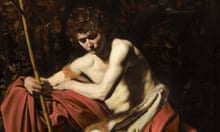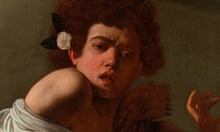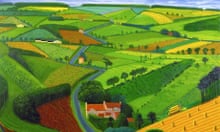David LaChapelle – Photographer and film director
Caravaggio is often called the most modern of the old masters – there's a newness, a contemporary feel to his work that painting prior to him just didn't have. It's like when [fashion designer Alexander] McQueen came on the scene, everything else [in the fashion world] suddenly looked old. Caravaggio used light like a photographer and his pictures are cropped like photographs. One that sticks in my mind is Boy Bitten By a Lizard. That's a beautiful example of the one-source light that we identify Caravaggio with, that he pioneered, but it's also a wonderful captured moment, this boy's sort of feminine reaction to the lizard's bite. It's a photograph before photography.
The flower in the boy's hair and the blouse coming off his shoulders I think signify that the boy is a male prostitute. But in no sense does Caravaggio judge the boy. He didn't strive to paint the court and the aristocracy – he was painting the courtesans and the street people, the hookers and the hustlers. That's who he felt comfortable with, empathised with. Back then that was considered blasphemous but actually that's where Jesus pulled his disciples from – the street people and the marginalised. That's why in [my photography series] Jesus Is My Homeboy I had people from the street dressed in modern clothing, in modern settings, with Christ, because that's who Jesus would be with if there was a second coming.
It's through one of my contemporary art heroes, Derek Jarman, that I got really turned on to the artist. I'm really good friends with John Maybury whose mentor was Jarman and when Jarman's film Caravaggio came out in the 80s I was living in London. It had a really big impact on me, I wanted to learn more about Caravaggio, I just loved his aesthetic. While Michelangelo was aspirational, using bodies at the height of perfection, Caravaggio was much more of a realist. The kind of beauty he depicts isn't in any sense what we see traditionally in painting of that time. He always found beauty in the unexpected, the ordinary – in the street urchin's face, the broken nose, and the heavy brow. That's why Caravaggio is a very sympathetic figure to me. I too try to find the beauty in everyone that I photograph, whether it's the kids in South Central LA who invented the new dance form I documented in Rize, or the transsexual Amanda Lepore who I've photographed a lot. People think she is freakish but I don't – I love her.
Today, if you took a photograph with the type of bodies Michelangelo used it would look like a [Calvin Klein] Obsession advert, whereas Caravaggio depicted the elderly, the imperfect, even death. You never turn your head away from a Caravaggio piece no matter how brutal it is because there's such a balance of horror, of unsightly bodies and violent scenes, with such great beauty.
Martin Scorsese – Film-maker
I was instantly taken by the power of [Caravaggio's] pictures. Initially I related to them because of the moment that he chose to illuminate in the story. The Conversion of St Paul, Judith Beheading Holofernes: he was choosing a moment that was not the absolute moment of the beginning of the action. You come upon the scene midway and you're immersed in it. It was different from the composition of the paintings that preceded it. It was like modern staging in film: it was so powerful and direct. He would have been a great film-maker, there's no doubt about it. I thought, I can use this too...
So then he was there. He sort of pervaded the entirety of the bar sequences in Mean Streets. He was there in the way I wanted the camera movement, the choice of how to stage a scene. It's basically people sitting in bars, people at tables, people getting up. The Calling of St Matthew, but in New York! Making films with street people was what it was really about, like he made paintings with them. Then that extended into a much later film, The Last Temptation of Christ. The idea was to do Jesus like Caravaggio.
Taken from Caravaggio: A Life Sacred and Profane by Andrew Graham-Dixon (Allen Lane). Read our review of this book
Peter Doig – Painter
It's always a challenge for a contemporary artist to be of their time but when you look at Caravaggio's paintings you can really imagine the context, because he used ordinary people and everyday clothes. The paintings feel very real. Edward Hopper, for instance, did the same. He was very aware of what people looked like in his time, what people were wearing. Equally Caravaggio's paintings were obviously very brave when they were made and they continue to be viewed with that spirit, and that's what's so exciting. The paintings are quite sinister – they have an air of menace, and they're obviously very sexual.
I first saw his work at the Royal Academy's Painting in Naples exhibition in the early 80s. I was in my early 20s then and I'd been aware of his work before but I'd not really paid it much attention. I found them immediately accessible, and quite different from other Renaissance paintings.
Sometimes the paintings actually don't seem quite right. I'm not talking about the straight portraits, but works like The Seven Acts of Mercy, where it looks as though he's looked at seven different incidents and then pieced together a picture out of these incidents. So there's no kind of logic to it in a realist way – it's not pretending to be a scene that you would actually see. In it two grown-up cherubs seem to be flying sideways. Initially you wonder what they're doing there because they seem very awkward. But when you twist your head you see they're obviously having sex. It's quite an extraordinary piece of painting in its own right within the full painting. I was quite excited and very surprised when I first saw that. It seemed very radical. I remember thinking that he must've enjoyed himself when he was making his work.
Polly Morgan – Taxidermist and artist
What I can see in a Caravaggio painting is as important as what is hidden. I might painstakingly spend months making something, only to light it in such a way that large parts of it are in shadow. Shadows need light to exist and what I love about Caravaggio's paintings are that the less he reveals, the more tactile and sculptural his figures become. I could compare it to pornography; show everything and it doesn't work, allude to something and it's compelling.
In Sleeping Cupid, there is a weight to Cupid's body that is absent in most depictions of him mid-flight. Here he looks spent. When I made my work To Every Seed his own Body, a blue tit collapsed on a miniature prayer book, I wanted to convey a sense of heaviness and fatigue through it's posture.
Caravaggio's elevation of the mundane and degenerate is what makes him unique for his time. He succeeds in bringing beauty to subjects that are commonly dismissed. This is something I've attempted in works where I've taken creatures that are typically considered vermin and shaped them in appealing ways. To have your take on beauty challenged is reinvigorating.
Polly Morgan's latest show, Psychopomps, is at Haunch of Venison, London W1, until 25 September.
Isaac Julien – Artist and film-maker
When I first saw Caravaggio's paintings in Rome I remember having what people call an art sickness. I was so in awe of the work, its aura and mastery – it was like a rapture. Bacon's works have this same kind of aura but it seems to be something that's missing a bit from contemporary art, which has other aims, other questions to pose.
I've always been interested in the use of lighting in Caravaggio's work. In the 80s I assistant-directed a film called Dreaming Rivers which we lit entirely by candlelight, a specific reference to Caravaggio's lighting. I even went with the cinematographer to look at some Caravaggios. I'm struck by the way his paintings use the architecture of light, its plasticity, how it forms the body, and I've borrowed that in several of my works. These things have been so astutely articulated in Caravaggio's works that they're almost, in a prophetic sense, cinematic. Making my documentary about Derek Jarman with Tilda Swinton I also saw this deliberate relationship [to Caravaggio's work] being made in Jarman's films, where basically there's an abandoning of sets as such. Instead he works with light and dark.
One work I find striking is The Denial of St Peter. It's a very troubling scene with such accusatory positioning. It's really about how things are communicated through the intensity of the gazes. But it's also the portions, the framing, the lighting, the colour, all of those aspects of communicating this particular moment. It's so cinematic.
Tom Hunter – Photographer and artist
For me, Caravaggio set the stage for what every contemporary artist seems to be striving for – to live an authentic life and then to talk about, to depict, that experience. Take Tracey Emin, sewing the names of everyone she slept with in a tent, or photographers like Nan Goldin and Sally Mann – their work is all about their own lives. You initially think all of Caravaggio's paintings are about God and religion but they're not, they're actually about his life and the times around him. They are living histories – that's why his work is so powerful for me.
There's a Caravaggio painting at the National Gallery called The Beheading of St John the Baptist, which I've returned to again and again. In it John the Baptist is on the floor; he has just been killed and Caravaggio gets the atmosphere totally right. Caravaggio was involved in a sword fight, and he actually killed someone: that's what seems to be recreated here, and that's why the morbid gravitas of that situation really comes out of the painting.
Caravaggio is like the opposite of the rich and famous fashion photographer of today, who would only be photographing Kate Moss. He was one of the first people to look at the ordinary people and tell their stories and that was really inspiring for me. In my series Living in Hell and Other Stories [shown at the National Gallery, 2005-2006] I wanted to talk about the everyday life around Hackney. I found a headline in the local paper about a woman being attacked in front of her children outside her council flat, which I depicted in Halloween Horror, a translation of Caravaggio's The Beheading of St John the Baptist. I wanted to record that horrific scene so it wasn't just a disposable headline, so that people would look at it and think, "My god, this isn't ordinary – a woman being mugged on her doorstep, in one of the richest cities in the world, in this day and age."
Of course the way he used light has also been an influence on me. The whole thing about photography is the painting of light – when I was taught photography I was told, "You shouldn't leave that bit too black because there's no detail there, you shouldn't have that bit too bright...", that sort of thing. But in Caravaggio's work there are amazing light contrasts and your imagination is left to explore the dark areas. His lighting has clearly been used in film too. Take Blade Runner, with its amazingly lit scenes, dark areas and beams of light through long corridors – that all seems to come from Caravaggio.







